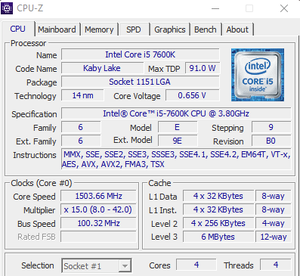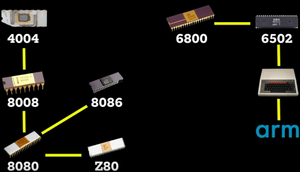CPU: Difference between revisions
No edit summary |
No edit summary |
||
| Line 1: | Line 1: | ||
'''Super Computers''' | |||
1943 ENIAC | 1943 ENIAC | ||
| Line 27: | Line 29: | ||
CDC | CDC | ||
CRAY[[File:Image.png|alt=CPU-Z Z270 i5-7600K|thumb|CPU-Z Z270 i5-7600K]] | CRAY | ||
1955: Shockley Semiconductor Laboratory (Caltech / MIT / Bell labs) | |||
1957: Fairchild Semiconductor (traitorous eight) | |||
1968: Intel (Noyce and Moore) | |||
1974: Zilog (Federico Faggin) | |||
[[File:Image.png|alt=CPU-Z Z270 i5-7600K|thumb|CPU-Z Z270 i5-7600K]] | |||
Fairchild, Intel, Motorola, TI, MOS, Zilog, Sun, Dec, IBM, ARM | Fairchild, Intel, Motorola, TI, MOS, Zilog, Sun, Dec, IBM, ARM | ||
Revision as of 06:55, 31 May 2024
Super Computers
1943 ENIAC
EDVAC
BINAC
1951 UNIVAC
ORDVAC
UNIVAC
UNISYS
ILLIAC
EDSAC
Manchaster Baby
CTC Computer Terminal Corporation
Datapoint 3300
ERA Remington Rand UNIVAC
CDC
CRAY
1955: Shockley Semiconductor Laboratory (Caltech / MIT / Bell labs)
1957: Fairchild Semiconductor (traitorous eight)
1968: Intel (Noyce and Moore)
1974: Zilog (Federico Faggin)
Fairchild, Intel, Motorola, TI, MOS, Zilog, Sun, Dec, IBM, ARM
Fairchild IC's (traitorous eight) Intel 4004, 8008, 8088 Zilog Z80 Motorola 6800 MOS 6502 Acorn ARM
RISC Berkley / IBM MIPS Stanford IBM PowerPC SUN Sparc DEC Alpha
MMX, SSE, SSE2, SSE3, SSSE3, SSE4.1, SSE4.2, EM64T, VT-x, AES, AVX, AVX2, FMA3, TSX
Moore's Law / Transistors
| Integration level | Year | Logic gates | ||
|---|---|---|---|---|
| MSI | Medium Scale Integration | 1976 | 20-200 | |
| LSI | Large‐scale integration | 1970 | 200-2000 | 10 µm |
| VLSI | Very large‐scale integration | 1980 | 2.000-20.000 | 1.5 µm |
| ULSI | Ultra large‐scale Integration | 1990 | 20.000-200.000 | 600 nm |
| SLSI | Super large‐scale integration | 2000 | 200.000- 2 million | 130 nm |
| 2010 | 2 million - 20 million | 22 nm | ||
| 2020 | 20 million - 200 million | 5 nm |
CISC v.s. RISC
RISC is a philosophy to use simpler instructions to achieve the same as complex instruction. For example for AES rowshifting an Intel can use XMM instructions to shift multiple rows in one operation, while RISC processors need to loop through the bytes and execute simpler instructions. It takes longer to execute, but without SIMD the processor is smaller, cheaper and wins in power efficiency.
Intel CISC
PCLMULHQHQDQ xmmreg,xmmrm
ARM RISC
result = operand1 EOR operand2;
for s = 0 to segments-1
Elem[result, s, 128] = AESSubBytes(AESShiftRows(Elem[result, s, 128]));
MIPS
1976: IBM 801 first conceptual RISC processor
1980: DARPA VLSI Project University funding
RISC Berkley (David Patterson)
MIPS Stanford University (John Hennessy)
1984 Company: MIPS Techology
1992 Acquired by SGI
1998 Divested
2013 Imagination (from PowerVR)
2022 Moved to RISC-V
Architecture and Licensing
Lexra
RISC
| University of Berkeley | Intended for research | |
| 1981 | RISC I | 44,500 transistors, 31 instructions, 78 32-bit registers |
| RISC Foundation | Open ISA free to implement | |
| 2015 | RISC V | |
ARM
Cortex-A Microprocessors, with an MMU, for Rich OS e.g. BSD/Linux/Windows)
Cortex-R Realtime processors
Cortex-M Microcontrollers for RTOS Task Scheduling
ARMv7-M ISA
M0+ von neuman (instruction and data share the same bus)
M3
M4
M7
ARMv8-M
M23 Trustzone
M33
M35P
Armv8.1-MM55
M85
Segger
SEGGER J-Link EDU Mini - JTAG/SWD Debugger
https://thepihut.com/products/segger-j-link-edu-mini-jtag-swd-debugger

